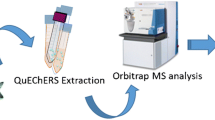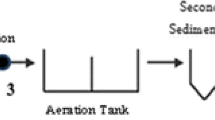Abstract
The emphasis of this research project was to develop and optimize a solid-phase extraction method and high-performance liquid chromatography-electrospray ionization-mass spectrometry method, such that a linkage between the detection of endocrine-active pharmaceuticals (EAPs) in the aquatic environment and subsequent effects on fish populations could eventually be studied. Four EAPs were studied: tamoxifen (TAM), exemestane (EXE), letrozole (LET), anastrozole (ANA); and three TAM metabolites: 4-hydroxytamoxifen, e/z endoxifen, and n-desmethyl tamoxifen. In aqueous matrices, the use of isotopically labeled standards for the EAPs allowed for the generation of good recoveries, greater than 80 %, and low relative standard deviations (% RSDs) (3 to 27 %). TAM metabolites had lower recoveries in the spiked water matrices: 35 to 93 % in waste/source water compared to 58 to 110 % in DI water. The precision in DI water was acceptable ranging from 8 to 38 % RSD. However, the precision in real environmental wastewaters could be poor, ranging from 15 to 120 % RSD, dependent upon unique matrix effects. In plasma, the overall recoveries of the EAPs were acceptable: 88 to 110 %, with %RSDs of 6 to 18 % (Table 3). The spiked recoveries of the TAM metabolites from plasma were good, ranging from 77 to 120 %, with %RSDs ranging from 27 to 32 %. Two of the TAM metabolites, 4-hydroxytamoxifen and n-desmethyl tamoxifen, were confirmed in most of the environmental aqueous samples. The discovery of TAM metabolites demonstrates that the source of the TAM metabolites, TAM, is constant, introducing a pseudo-persistence of this chemical into the environment.

Similar content being viewed by others
References
USEPA (2014) Pharmaceuticals and Personal Care Products (PPCPs): Bibliographic Database of Relevant Published Literature. USEPA. http://www.epa.gov/ppcp/lit.html
Steiner AZ, Terplan M, Paulson RJ (2005) Comparison of tamoxifen and clomiphene citrate for ovulation induction: a meta-analysis. Hum Reprod 20(6):1511–1515
Parker L, Gray D, Lai M, Levin E (1986) Treatment of gynecomastia with tamoxifen: a double-blind crossover study. Metabolism 35(8):705–708
Yildiz A, Guleryuz S, Ankerst D, Öngür D, Renshaw PF (2008) Protein kinase c inhibition in the treatment of mania: a double-blind, placebo-controlled trial of tamoxifen. Arch Gen Psychiatry 65(3):255–263. doi:10.1001/archgenpsychiatry.2007.43
Sun L, Zha J, Spear PA, Wang Z (2007) Tamoxifen effects on the early life stages and reproduction of Japanese medaka (Oryzias latipes). Environ Toxicol Pharmacol 24(1):23–29. doi:10.1016/j.etap.2007.01.003
Santos SMA, Videira RA, Fernandes MAS, Santos MS, Moreno AJM, Vicente JAF, Jurado AS (2014) Toxicity of the herbicide linuron as assessed by bacterial and mitochondrial model systems. Toxicol in Vitro 28(5):932–939. doi:10.1016/j.tiv.2014.04.004
Furr BJA, Jordan VC (1984) The pharmacology and clinical uses of tamoxifen. Pharmacol Ther 25(2):127–205. doi:10.1016/0163-7258(84)90043-3
Mater N, Geret F, Castillo L, Faucet-Marquis V, Albasi C, Pfohl-Leszkowicz A (2014) In vitro tests aiding ecological risk assessment of ciprofloxacin, tamoxifen and cyclophosphamide in range of concentrations released in hospital wastewater and surface water. Environ Int 63:191–200. doi:10.1016/j.envint.2013.11.011
Faglia G, Arosio M, Porretti S (2000) Delayed closure of epiphyseal cartilages induced by the aromatase inhibitor anastrozole. Would it help short children grow up? J Endocrinol Investig 23(11):721–723. doi:10.1007/BF03345059
Besse J-P, Latour J-F, Garric J (2012) Anticancer drugs in surface waters: what can we say about the occurrence and environmental significance of cytotoxic, cytostatic and endocrine therapy drugs? Environ Int 39(1):73–86. doi:10.1016/j.envint.2011.10.002
Sun L, Zha J, Spear PA, Wang Z (2007) Toxicity of the aromatase inhibitor letrozole to Japanese medaka (Oryzias latipes) eggs, larvae and breeding adults. Comp Biochem Physiol C 145(4):533–541. doi:10.1016/j.cbpc.2007.01.017
Belaid B, Richard-Mercier N, Pieau C, Dorizzi M (2001) Sex reversal and aromatase in the European pond turtle: treatment with letrozole after the thermosensitive period for sex determination. J Exp Zool 290:490–497
Liao P-H, Chu S-H, Tu T-Y, Wang X-H, Lin AY-C, Chen P-J (2014) Persistent endocrine disruption effects in medaka fish with early life-stage exposure to a triazole-containing aromatase inhibitor (letrozole). J Hazard Mater 277:141–149. doi:10.1016/j.jhazmat.2014.02.013
Liu X, Zhang J, Yin J, Duan H, Wu Y, Shao B (2010) Analysis of hormone antagonists in clinical and municipal wastewater by isotopic dilution liquid chromatography tandem mass spectrometry. Anal Bioanal Chem 396(8):2977–2985. doi:10.1007/s00216-010-3531-0
Fick J, Lindberg RH, Kaj L, Brorström-Lundén E (2011) Results from the Swedish National Screening Programme 2010: Subreport 3: Pharmaceuticals. Screening 2010, vol IVL Report B2014. IVL Swedish Environmental Research Institute Ltd., Stockholm Sweden
Hilton MJ, Thomas KV (2003) Determination of selected human pharmaceutical compounds in effluent and surface water samples by high-performance liquid chromatography‚Äìelectrospray tandem mass spectrometry. J Chromatogr A 1015(1–2):129–141. doi:10.1016/s0021-9673(03)01213-5
Roberts PH, Thomas KV (2006) The occurrence of selected pharmaceuticals in wastewater effluent and surface waters of the lower Tyne catchment. Sci Total Environ 356(1–3):143–153. doi:10.1016/j.scitotenv.2005.04.031
Runnalls TJ, Margiotta-Casaluci L, Kugathas S, Sumpter JP (2010) Pharmaceuticals in the aquatic environment: steroids and anti-steroids as high priorities for research. Hum Ecol Risk Assess 16(6):1318–1338. doi:10.1080/10807039.2010.526503
Thomas KV, Hilton MJ (2004) The occurrence of selected human pharmaceutical compounds in UK estuaries. Mar Pollut Bull 49(5–6):436–444. doi:10.1016/j.marpolbul.2004.02.028
Zhou JL, Zhang ZL, Banks E, Grover D, Jiang JQ (2009) Pharmaceutical residues in wastewater treatment works effluents and their impact on receiving river water. J Hazard Mater 166:655–661. doi:10.1016/j.jhazmat.2008.11.070
Gros M, PetrovicÃÅ M, BarceloÃÅ D (2008) Tracing pharmaceutical residues of different therapeutic classes in environmental waters by using liquid chromatography/quadrupole-linear ion trap mass spectrometry and automated library searching. Anal Chem 81(3):898–912. doi:10.1021/ac801358e
Negreira N, López de Alda M, Barceló D (2013) On-line solid phase extraction–liquid chromatography–tandem mass spectrometry for the determination of 17 cytostatics and metabolites in waste, surface and ground water samples. J Chromatogr A 1280:64–74. doi:10.1016/j.chroma.2013.01.031
López-Serna R, Petrović M, Barceló D (2011) Development of a fast instrumental method for the analysis of pharmaceuticals in environmental and wastewaters based on ultra high performance liquid chromatography (UHPLC)–tandem mass spectrometry (MS/MS). Chemosphere 85(8):1390–1399. doi:10.1016/j.chemosphere.2011.07.071
Wang J, Gardinali PR (2013) Uptake and depuration of pharmaceuticals in reclaimed water by mosquito fish (Gambusia holbrooki): a worst-case, multiple-exposure scenario. Environ Toxicol Chem 32(8):1752–1758. doi:10.1002/etc.2238
Ferrando-Climent L, Rodriguez-Mozaz S, Barceló D (2013) Development of a UPLC-MS/MS method for the determination of ten anticancer drugs in hospital and urban wastewaters, and its application for the screening of human metabolites assisted by information-dependent acquisition tool (IDA) in sewage samples. Anal Bioanal Chem 405(18):5937–5952. doi:10.1007/s00216-013-6794-4
Ferrando-Climent L, Rodriguez-Mozaz S, Barceló D (2014) Incidence of anticancer drugs in an aquatic urban system: from hospital effluents through urban wastewater to natural environment. Environ Pollut 193:216–223. doi:10.1016/j.envpol.2014.07.002
Iglesias A, Nebot C, Vázquez B, Coronel-Olivares C, Abuín C, Cepeda A (2014) Monitoring the presence of 13 active compounds in surface water collected from rural areas in northwestern Spain. Int J Environ Res Publ Health 11(5):5251–5272
Berlioz-Barbier A, Vauchez A, Wiest L, Baudot R, Vulliet E, Cren-Olivé C (2014) Multi-residue analysis of emerging pollutants in sediment using QuEChERS-based extraction followed by LC-MS/MS analysis. Anal Bioanal Chem 406(4):1259–1266. doi:10.1007/s00216-013-7450-8
Vulliet E, Berlioz-Barbier A, Lafay F, Baudot R, Wiest L, Vauchez A, Lestremau F, Botta F, Cren-Olivé C (2014) A national reconnaissance for selected organic micropollutants in sediments on French territory. Environ Sci Pollut Res 21(19):11370–11379. doi:10.1007/s11356-014-3089-z
Alvarez D, Petty J, Huckins J, Jones-Lepp T, Getting D, Goddard J, Manahan S (2004) Development of a passive, in situ, integrative sampler for hydrophilic organic contaminants in aquatic environments. Environ Toxicol Chem 23:1640–1648
Jones-Lepp TL, Sanchez C, Alvarez DA, Wilson DC, Taniguchi-Fu R-L (2012) Point sources of emerging contaminants along the Colorado River Basin: source water for the arid Southwestern United States. Sci Total Environ 430:237–245. doi:10.1016/j.scitotenv.2012.04.053
Alvarez D, Cranor W, Perkins S, Clark R, Smith S (2008) Chemical and toxicological assessment of organic contaminants in surface water using passive samplers. J Environ Qual 37:1024–1033
MacDougall D, Crummett WB (1980) Guidelines for data acquisition and data quality evaluation in environmental chemistry. Anal Chem 52(14):2242–2249. doi:10.1021/ac50064a004
Teunissen SF, Jager NGL, Rosing H, Schinkel AH, Schellens JHM, Beijnen JH (2011) Development and validation of a quantitative assay for the determination of tamoxifen and its five main phase I metabolites in human serum using liquid chromatography coupled with tandem mass spectrometry. J Chromatogr B 879(19):1677–1685. doi:10.1016/j.jchromb.2011.04.011
USEPA (2007) Method 1694: pharmaceuticals and personal care products in water, soil, sediment, and biosolids by HPLC/MS/MS. US Environmental Protection Agency, Washington, DC
Morin N, Camilleri J, Cren-Olivé C, Coquery M, Miège C (2013) Determination of uptake kinetics and sampling rates for 56 organic micropollutants using “pharmaceutical” POCIS. Talanta 109:61–73. doi:10.1016/j.talanta.2013.01.058
Bartelt-Hunt SL, Snow DD, Damon T, Shockley J, Hoagland K (2009) The occurrence of illicit and therapeutic pharmaceuticals in wastewater effluent and surface waters in Nebraska. Environ Pollut 157(3):786–791. doi:10.1016/j.envpol.2008.11.025
Daughton C (2002) Environmental stewardship and drugs as pollutants. Lancet 360(9339):1035–1036
Rand-Weaver M, Margiotta-Casaluci L, Patel A, Panter GH, Owen SF, Sumpter JP (2013) The read-across hypothesis and environmental risk assessment of pharmaceuticals. Environ Sci Technol 47(20):11384–11395. doi:10.1021/es402065a
Ankley GT, Bennett RS, Erickson RJ, Hoff DJ, Hornung MW, Johnson RD, Mount DR, Nichols JW, Russom CL, Schmieder PK, Serrrano JA, Tietge JE, Villeneuve DL (2010) Adverse outcome pathways: a conceptual framework to support ecotoxicology research and risk assessment. Environ Toxicol Chem 29(3):730–741. doi:10.1002/etc.34
Acknowledgments
TLJL would like to thank her anonymous reviewers for their considerate and careful reviews. This paper is dedicated in memory of Dr. Theo Colburn, a pioneer in the study of environmental endocrine disruption; she was a true champion for the environment.
Notice
The US Environmental Protection Agency through its Office of Research and Development funded and managed the research described here. It has been subjected to the agency’s administrative review and approved for publication. Mention of trade names or commercial products does not constitute endorsement or recommendation for use.
Author information
Authors and Affiliations
Corresponding author
Electronic supplementary material
Below is the link to the electronic supplementary material.
ESM 1
(PDF 1727 kb)
Rights and permissions
About this article
Cite this article
Jones-Lepp, T.L., Taniguchi-Fu, R.L., Morgan, J. et al. Developing analytical approaches to explore the connection between endocrine-active pharmaceuticals in water to effects in fish. Anal Bioanal Chem 407, 6481–6492 (2015). https://doi.org/10.1007/s00216-015-8813-0
Received:
Revised:
Accepted:
Published:
Issue Date:
DOI: https://doi.org/10.1007/s00216-015-8813-0




